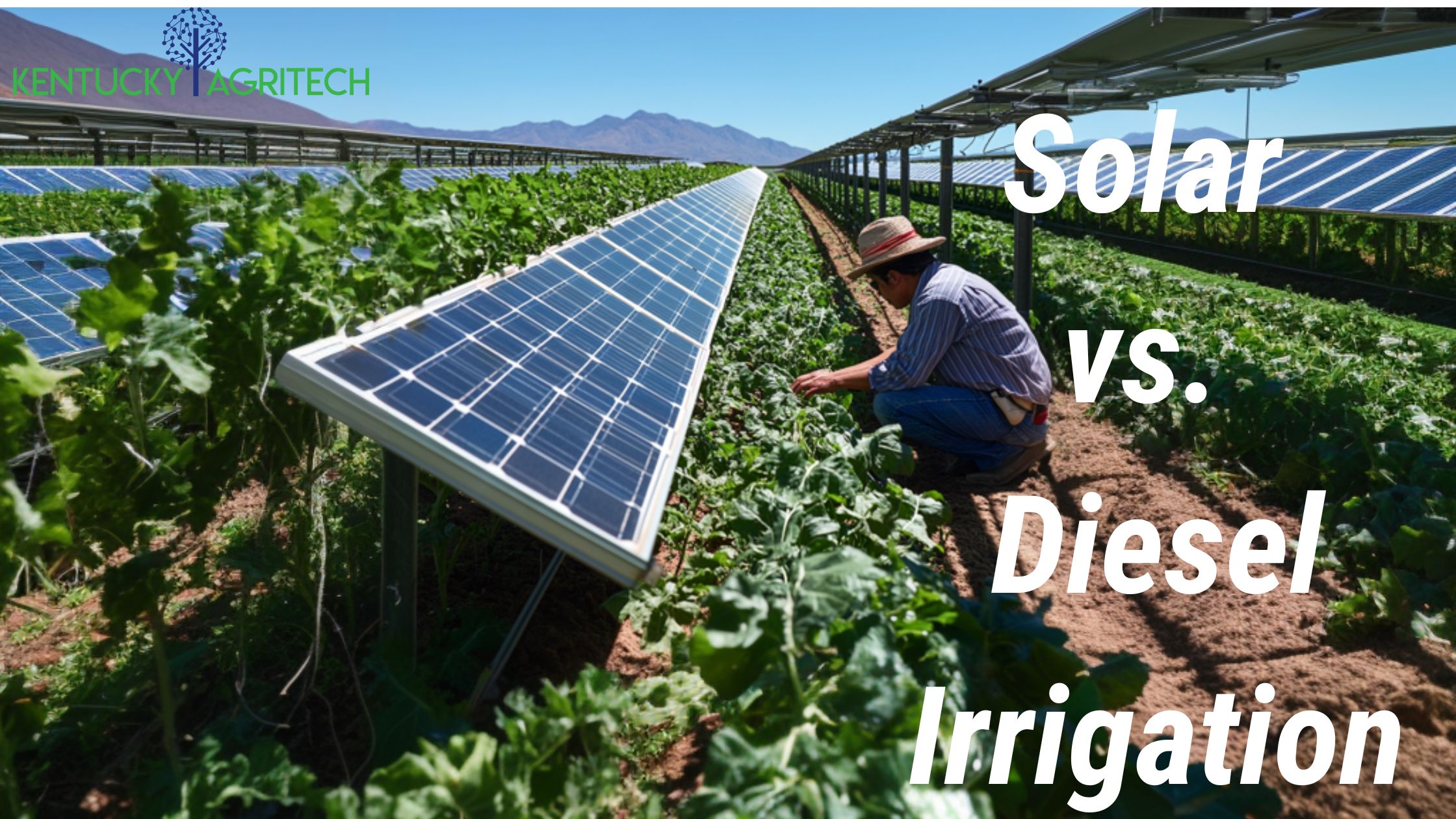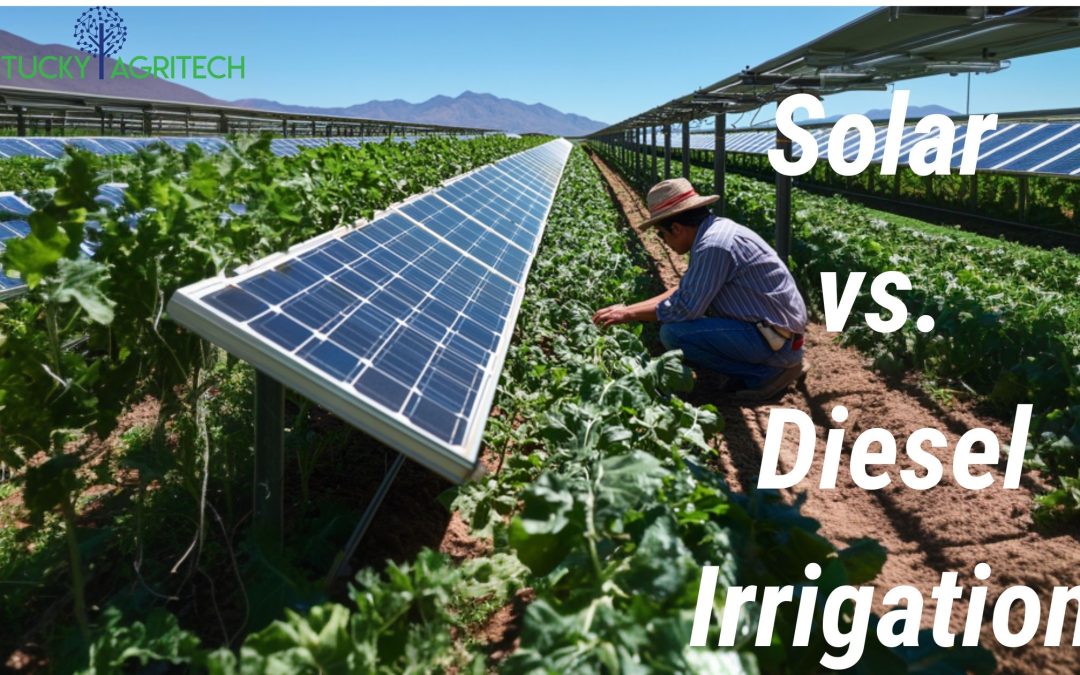
As the agricultural industry becomes more focused on sustainability and cost-efficiency, many farmers are choosing between solar-powered irrigation systems (SPIS) and diesel-powered irrigation systems. Both options offer advantages, but which system provides the best long-term savings and environmental benefits? In this article, we’ll explore the cost comparison of solar versus diesel irrigation, and how solar irrigation is already transforming farming in several countries around the world.
Initial Investment: Solar-Powered Irrigation vs. Diesel-Powered Irrigation
Solar-Powered Irrigation Systems (SPIS):
- Upfront Costs: Installing a solar irrigation system includes costs for solar panels, pumps, mounting structures, and optional water storage. The investment typically ranges from $2,000 to $10,000, depending on the size and complexity of the system.
- High Initial Investment: Solar systems come with higher upfront costs due to the photovoltaic (PV) panels and infrastructure, typically costing around $2,500 to $3,000 per kW of power. However, these systems offer significant long-term savings due to minimal operating costs.
Diesel-Powered Irrigation Systems:
- Upfront Costs: Diesel-powered systems are cheaper initially, typically costing between $500 and $5,000 for a pump and fuel storage tank.
- Lower Initial Cost: Diesel systems usually have a lower upfront cost, with prices for diesel pumps ranging from $500 to $800 per kW, making them attractive for farmers who need an immediate and low-cost solution.
Operational and Maintenance Costs
Solar-Powered Irrigation:
- Energy Costs: Solar-powered irrigation benefits from zero energy costs once the system is installed. Solar energy is free, so farmers do not face recurring fuel or electricity expenses.
- Maintenance: Solar systems require low maintenance, mainly consisting of cleaning panels and checking the pumps. If batteries are included for energy storage, these may need replacement every 5-10 years.
- Annual Maintenance Costs: On average, maintenance for solar systems costs around $100 to $300 per year.
Diesel-Powered Irrigation:
- Fuel Costs: Diesel systems require constant refueling. A diesel pump operating 5 hours a day for 100 days during peak irrigation can consume about $2,000 to $2,500 worth of fuel annually.
- Maintenance: Diesel engines need regular maintenance, including oil changes and filter replacements, as well as potential repairs.
- Annual Maintenance Costs: Diesel-powered systems typically cost between $300 and $1,000 annually for maintenance and fuel.
Long-Term Cost Comparison: Solar vs. Diesel Irrigation Systems
| Cost Component | Solar-Powered Irrigation | Diesel-Powered Irrigation |
|---|---|---|
| Initial System Cost | $2,000 – $10,000+ | $500 – $5,000+ |
| Energy Costs | Zero | $2,000 – $2,500 annually |
| Maintenance Costs | $100 – $300 annually | $300 – $1,000 annually |
| Lifespan | 25+ years (solar panels) | 5-10 years (pump engine) |
| Total 5-Year Cost | $2,500 – $11,500 | $10,000 – $18,000 |
| Total 10-Year Cost | $3,000 – $13,000 | $20,000 – $30,000 |
| Total 20-Year Cost | $4,000 – $16,000 | $40,000 – $60,000 |
Global Adoption of Solar-Powered Irrigation
Many countries are already seeing the benefits of solar-powered irrigation, improving farm productivity and sustainability while reducing costs.
- India: India has been a global leader in adopting solar irrigation systems. The country’s government offers subsidies and financing options to encourage farmers to switch from diesel to solar pumps. Programs like KUSUM (Kisan Urja Suraksha evam Utthaan Mahabhiyan) aim to install over 2 million solar pumps in the coming years, reducing diesel consumption and empowering farmers to achieve energy independence.
- Bangladesh: Solar irrigation is playing a critical role in Bangladesh’s agricultural sector, particularly in regions where grid electricity is unreliable. Organizations like the Infrastructure Development Company Limited (IDCOL) have installed over 1,000 solar-powered irrigation pumps to reduce diesel dependency and support rural farmers.
- Kenya: In Kenya, solar irrigation is improving food security in arid and semi-arid regions. Solar pumps provide farmers with reliable access to water, helping them grow crops year-round. With increasing adoption, Kenyan farmers are benefiting from lower operating costs and increased crop yields.
- Sudano-Sahel (Africa): Solar-powered drip irrigation systems have been transformative in parts of the Sudano-Sahel region. Studies, like those conducted in Northern Benin, have shown that solar irrigation has increased vegetable production and improved nutrition for local farmers, who no longer rely on traditional hand-watering methods.
- Jordan: In Jordan, solar-powered irrigation has been integrated with high-tech greenhouses to optimize resource use. Commercial farms are using solar energy to power irrigation pumps, cooling systems, and lighting, improving water efficiency and crop yields in one of the world’s most water-scarce regions.
Environmental Impact: Solar vs. Diesel
Solar-Powered Irrigation:
- Zero Emissions: Solar-powered irrigation systems do not produce any emissions once installed. They help farmers reduce their carbon footprint and contribute to more sustainable agricultural practices.
- Renewable Energy: Solar energy is renewable, ensuring that the system continues to operate without depleting natural resources. This makes it a long-term solution for environmentally conscious farmers.
Diesel-Powered Irrigation:
- High Emissions: Diesel systems contribute to CO2 emissions, generating around 2.68 kg of CO2 per liter of diesel used. Over time, this leads to significant environmental damage.
- Non-Renewable Energy: Diesel is a finite resource, subject to market fluctuations and price increases, making it a less reliable and sustainable energy source in the long term.
Break-Even Point for Solar-Powered Irrigation Systems
Though solar-powered irrigation systems have higher upfront costs, they typically reach a break-even point within 5-7 years, thanks to energy savings and reduced maintenance costs. Once this point is reached, farmers enjoy free energy and significantly lower operating expenses. In contrast, diesel systems continue to incur high fuel and maintenance costs over time.
Which System Is Right for Your Farm?
-
Solar-Powered Irrigation:
- Best for farmers seeking long-term cost savings, sustainability, and independence from fossil fuels.
- Ideal for regions with high solar irradiance or access to government subsidies.
- Provides energy reliability for remote or off-grid areas.
-
Diesel-Powered Irrigation:
- Suitable for farmers who need an immediate and low-cost irrigation solution.
- Works well in areas where sunlight is unreliable, or where fuel is readily available at a low cost.
- Requires ongoing fuel and maintenance expenses, making it more costly over time.
Conclusion: Solar-Powered Irrigation Is the Future of Sustainable Farming
When comparing solar vs. diesel irrigation, it’s clear that solar-powered systems offer superior long-term savings, energy independence, and sustainability. Countries like India, Bangladesh, Kenya, and Jordan are already leading the way, demonstrating how solar irrigation can transform farming practices and improve food security.
By switching to solar irrigation, farmers can reduce their operating costs, increase crop yields, and contribute to a more sustainable future for agriculture.
Interested in learning more about solar irrigation? Contact KY AgriTech today and discover how you can power your farm sustainably!
#SolarIrrigation #DieselIrrigation #SustainableFarming #RenewableEnergy #GlobalAdoption


Recent Comments